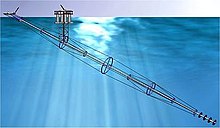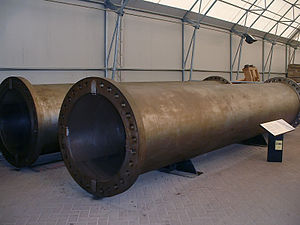Space gun

A space gun, sometimes called a Verne gun because of its appearance in
In
Technical issues
The large
Getting to orbit
A space gun by itself is not capable of placing objects into a stable orbit around the object (planet or otherwise) they are launched from. The orbit is a
A rocket can be used for additional boost, as planned in both
In a three-body or larger system, a gravity assist trajectory might be available such that a carefully aimed escape velocity projectile would have its trajectory modified by the gravitational fields of other bodies in the system such that the projectile would eventually return to orbit the initial planet using only the launch delta-v.[2][3]
Isaac Newton avoided this objection in his thought experiment by placing his notional cannon atop a tall mountain and positing negligible air resistance. If in a stable orbit, the projectile would circle the planet and return to the altitude of launch after one orbit (see Newton's cannonball).[4]
Acceleration
For a space gun with a gun barrel of length (), and the needed velocity (), the acceleration () is provided by the following formula:[citation needed]
For instance, with a space gun with a vertical "gun barrel" through both the Earth's crust and the troposphere, totalling ~60 km (37 miles) of length (), and a velocity () enough to escape the Earth's gravity (escape velocity, which is 11.2 km/s or 25,000 mph on Earth), the acceleration () would theoretically be more than 1,000 m/s2 (3,300 ft/s2), which is more than 100 g-forces, which is about 3 times the human tolerance to g-forces of maximum 20 to 35 g[5] during the ~10 seconds such a firing would take.This calculation does not take into account the decreasing escape velocity at higher altitudes.
Practical attempts


V3 Cannon (1944-45)
The German
Super High Altitude Research Project (1985-95)
The US
Project Babylon (1988-90)
The most prominent recent attempt to make a space gun was artillery engineer Gerald Bull's Project Babylon, which was also known as the 'Iraqi supergun' by the media. During Project Babylon, Bull used his experience from Project HARP to build a massive cannon for Saddam Hussein, leader of Ba'athist Iraq. Bull was assassinated before the project was completed.[7]
Quicklaunch (1996-2016)
After cancellation of SHARP, lead developer
Ram accelerators have also been proposed as an alternative to light-gas guns. Other proposals use electromagnetic techniques for accelerating the payload, such as coilguns and railguns.[citation needed]
In fiction

The first publication of the concept may be
Perhaps the most famous representations of a space gun appear in
In the 1991 video game Ultima: Worlds of Adventure 2: Martian Dreams, Percival Lowell builds a space gun to send a spacecraft to Mars.
The 1992 video game Steel Empire, a shoot 'em up with steampunk aesthetics, features a space gun in its seventh level that is used by the main villain General Styron to launch himself to the Moon.
In
The 2015 video game SOMA features a space gun used to launch satellites.
In the 2004 role-playing game Paper Mario: The Thousand-Year Door, a village of Bob-ombs operates a space gun to send Paper Mario and company to the X-Naut's base on the Moon.
Gerald Bull and Project Babylon are integral to the plot of Louise Penny's 2015 novel The Nature of the Beast.
See also
- Geostationary orbit: circular orbit 35,786 km (22,236 miles) above the Earth used by communications satellites
- Newton's cannonball
- The Fist of God
- SHARP
- Quicklaunch
- SpinLaunch
- StarTram
- Mass driver
- Space elevator
- Launch loop
- Lightcraft
- Space fountain
- Tether propulsion
- Non-rocket spacelaunch
References
- ^ "StarTram2010: Maglev Launch: Ultra Low Cost Ultra High Volume Access to Space for Cargo and Humans". startram.com. Retrieved April 28, 2011.
- ^ Clarke, Victor C. Jr. (1970-04-10), An Essay On the Application and Principle of Gravity-Assist Trajectories For Space Flight (PDF), Jet Propulsion Laboratory, California Institute of Technology, p. 7, archived from the original (PDF) on 2016-04-18, retrieved 2013-08-13,
By induction then, it is obvious that the process of diverting a spacecraft from one planet to another might be continued indefinitely, if the planets were in favorable positions.
- ^ Minovitch, Michael (August 23, 1961), A Method For Determining Interplanetary Free-Fall Reconnaissance Trajectories (PDF), Jet Propulsion Laboratory Technical Memos, pp. 38–44
- ^ Newton, Isaac (1728). A Treatise of the System of the World. F. Fayram. pp. 6–12.
- ^ "David Purley Bio". Anton Sukup's Autographs of F1 Drivers. Retrieved July 31, 2006.
Purley was subjected to the highest G-forces ever survived by a human being - 179.8G - when the car went from 108mph to zero in just over half a meter
- ^ RAF staff (6 April 2005). "RAF History - Bomber Command 60th Anniversary". Bomber Command: Campaign Diary. RAF. Archived from the original on 6 July 2007. Retrieved 23 October 2013.
- ISBN 978-0-89141-438-4.
- ^ "Quicklaunch Affordable Space Access". TekLaunch Inc. Archived from the original on 2011-07-24.
{{cite web}}: CS1 maint: unfit URL (link) - ^ "Jules Verne Launcher Company Concept". astronautix.com. Archived from the original on August 27, 2002. Retrieved November 11, 2011.
- ^ Elahi, Amina (January 15, 2010). "A Cannon for Shooting Supplies into Space". Popular Science. Retrieved November 11, 2011.
- ^ Greg Goebel (1 November 2019). "[4.0] Space Guns". Spaceflight Propulsion (v1.4.0 ed.).




